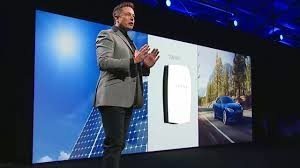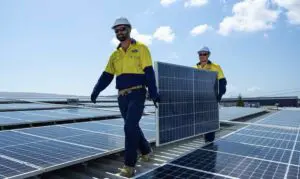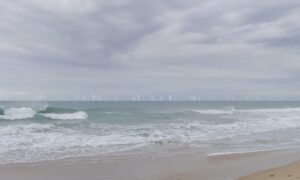Sales of one of the world’s most talked about energy storage technologies, the Tesla Powerwall residential battery unit, have officially kicked off in Australia, as the first three local installers were unveiled on Thursday.
Electricity retailers Origin Energy and Simply Energy, and Sydney-based solar installer Natural Solar are among the first to be named in what will be a growing list of “authorised resellers” of the sleek-looking 7kWh Powerwall, with Origin saying it would begin sales of the battery unit immediately, with installations expected to begin in February 2016.
Natural Solar, meanwhile, says it plans to begin installing the Tesla batteries across four states and in the ACT in January, as part of its latest 4- and 5kW rooftop solar offerings.
Natural Solar managing director Chris Williams told OneStepOffTheGrid on Thursday that he expected to be able to offer his customers a 4kW solar system with the 7kWh Powerwall integrated using a Fronius hybrid inverter for around $13,990 (GST inclusive and fully installed), with added meter costs. $14,990 for a 5kW solar system.
Coupling the Powerwall with a 4kW SolarEdge system would cost slightly more, at $15,390, Williams said.
Williams also told OneStep that he believed that both the market and the technology were at the crucial point where customers could potentially be offered a zero deal offer on a solar plus storage system using the Tesla Powerwall.
“With the right set up, (such a deal could) see the customer be cash-flow positive immediately and own the system outright within seven years,” Williams said.
Origin, meanwhile, is bundling the Tesla Powerwall with Trina solar panels and the Solar Edge inverter as part of a home energy solution it will offer its customers – including the more than 400,000 with rooftop solar – the retailer said in a release. No price was mentioned.
The announcement of the Australian Powerwall resellers was foreshadowed by Tesla on Wednedsay, with a statement confirming that Australians would be able to “put their money down” for the batteries before Christmas, with delivery expected in early 2016.
The Powerwall – which was originally designed purely for the residential energy storage stprage market, to be coupled with solar – will mostly be offered in Australia as a 7 kWh unit, although Tesla has said it will also offer a 10kWh unit that can store power for a week, for backup use.
As we have noted, it is by no means the only battery storage offering – or potentially even the cheapest – on the Australian market, with a large and growing number of different-sized battery storage systems now being offered, as well as a variety of different chemistries.
 But the Powerwall has been one of the most talked about technologies in the energy storage space, its arrival on the scene often credited with putting a rocket under the sector. Certainly, demand for the Powerwall – and other battery systems – in Australia is expected to be considerable.
But the Powerwall has been one of the most talked about technologies in the energy storage space, its arrival on the scene often credited with putting a rocket under the sector. Certainly, demand for the Powerwall – and other battery systems – in Australia is expected to be considerable.
According to Williams, the number of inquiries his company has fielded about the Powerwall, specifically, have been “staggering”.
“I have never experienced customers who have no experience quoting on solar or energy storage systems ringing up who just say ‘I want a Tesla’,” he told OneStep.
This brand of customer, coupled with those Williams estimates make up the around 50 per cent of new rooftop solar owners with hybrid system inverters already installed – in the anticipation of adding storage – should see sales set off at quite a clip.
“We see the demand is going to be great,” Williams said. “It’s really a case of rolling it out correctly initially, and then ramping it up in Q2.”
With its head office in Sydney, Natural Solar has installers four capital cities – Melbourne, Brisbane and Adelaide – plus Canberra, and says it is confident that the quantity of units it will get from Tesla will meet customer demand.
Williams says all of his installers have had individual training with Tesla, as well as broader training on energy storage installation, to facilitate a smooth process.
“The standards expected of us being an authorised Tesla reseller are incredibly high,” he told OneStep. “We have been speaking with Tesla for a long time and actively pursuing them.
 “I think one of the things that attracted us was that they are such a large company and offer a very sound warranty.”
“I think one of the things that attracted us was that they are such a large company and offer a very sound warranty.”
Williams says his company was also attracted to the fact that the Tesla battery was that it was “very clearly” designed for households with solar – his bread and butter.
“The Powerwall very clearly not designed as an off-grid solution,” Williams said.
Likewise, he added, “we’re not trying to get rid of grid 100 per cent. I think it’s still highly beneficial. We’re just trying to work to a standard bell curve and cut out 60-80 per cent of our customers’ bill.”
Other advantages of the Powerwall, he says, are that its lithium-ion chemistry means it can be installed indoors or out, and is functional for both single and three phase households (the latter requiring multiple units). It can also be islanded from the grid in the event of a blackout, Williams adds.
“The world has been waiting for a product just like this unit and we are proud to be at the forefront of its installation throughout the country,” he said.
“We see this opportunity as, a chance to educate the public on this ground-breaking technology and more. Australians are among the world’s early adopters of renewable energy technology.”
This article was originally published on RenewEconomy sister site, One Step Off The Grid. To subscribe to the weekly newsletter, click here.








